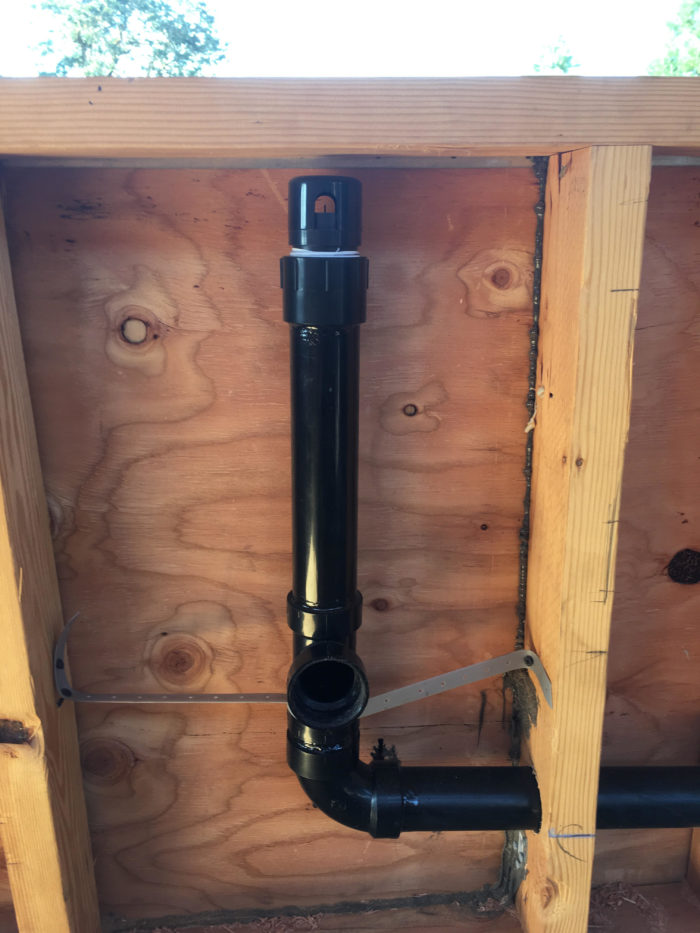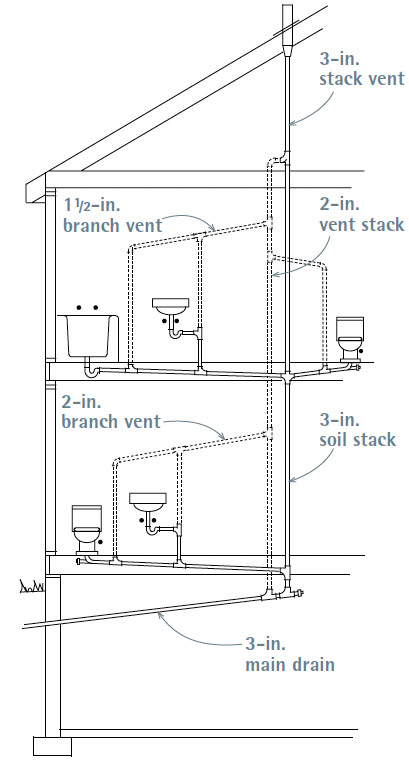The Benefits of Proper Ventilation in Your Plumbing System
The Benefits of Proper Ventilation in Your Plumbing System
Blog Article
Almost everyone seems to have their private rationale involving The Upsides of Proper Ventilation in Plumbing Design.

Appropriate air flow in plumbing systems is usually overlooked, yet it is crucial for preserving the functionality and safety of your home's pipes. Air flow helps control air pressure, protect against the buildup of harmful gases, and ensure the effective removal of waste. In this guide, we will certainly discover the significance of appropriate pipes air flow, how it functions, and the advantages it offers your pipes system.
Understanding Ventilation in Pipes
Ventilation in plumbing describes the network of pipes that enable air to flow through the drain system. These vents serve multiple objectives, consisting of controling atmospheric pressure within the pipelines, protecting against sewage system gases from getting in the home, and helping in the smooth flow of wastewater.
How Air Flow Works in Pipes Equipments
Air Pressure Policy
Appropriate air flow keeps well balanced air pressure within the pipes system. When water flows via pipelines, it displaces air. Without appropriate ventilation, this displacement can produce unfavorable stress, causing slow down drains or siphoning of water from traps, which can cause undesirable odors to permeate into the home.
Preventing Sewage System Gas Buildup
One of one of the most essential functions of plumbing vents is to avoid sewer gases, such as methane and hydrogen sulfide, from accumulating within the home. These gases can present severe wellness threats and are extremely combustible. Vent pipelines enable these gases to run away safely outside.
Helping in Waste Elimination
Ventilation assists in the effective elimination of wastewater by stopping airlocks in the water drainage system. When air can flow easily through the vents, it permits water and waste to stream smoothly via the pipes, minimizing the danger of blockages and backups.
Kinds Of Plumbing Vents
Key Heap Vent
The main stack air vent, also referred to as the air vent pile, is the key air vent in a plumbing system. It extends from the major drainpipe line up via the roofing, enabling gases to get away and fresh air to enter the system.
Branch Vent
Branch vents connect to the major pile air vent and offer private fixtures, such as sinks, commodes, and showers. These vents make certain that each fixture has adequate ventilation to function properly.
Air Admission Shutoff (AAV).
An Air Admittance Valve (AAV) is a one-way shutoff that enables air to go into the plumbing system without the need for a typical vent pipe extending through the roof. AAVs are typically used in renovations or areas where installing a standard air vent is impractical.
Indicators of Poor Ventilation in Plumbing.
Slow Draining Fixtures.
If your sinks, tubs, or commodes are draining gradually, maybe an indication of inadequate air flow. Insufficient air flow can develop a vacuum cleaner effect, making it difficult for water to drain pipes properly.
Gurgling Appears.
Gurgling audios originating from drains are frequently an outcome of air being sucked via water traps due to adverse pressure in the pipes. This is a clear indicator of insufficient air flow.
Unpleasant Odors.
Drain odors inside your home are a warning that your plumbing system is not properly ventilated. This might mean that drain gases are not being effectively vented outside, bring about potentially dangerous problems.
Typical Air Flow Mistakes.
Poor Vent Sizing.
Utilizing undersized vent pipes can bring about inadequate air flow and stress inequalities in the system. It's vital to utilize vents that meet the particular requirements of your plumbing system.
Improper Vent Positioning.
Positioning vents as well far from the fixtures they serve can lower their performance. Proper positioning guarantees that air can move easily and successfully with the system.
Disregarding Code Needs.
Building codes provide details standards for plumbing ventilation. Neglecting these codes can cause a system that stops working to operate appropriately and may result in costly repairs or carcinogen.
Advantages of Appropriate Ventilation.
Enhanced System Performance.
Effectively ventilated pipes systems operate much more effectively, with fewer obstructions, faster draining, and much less strain on the pipes. This performance extends the life expectancy of the plumbing system.
Improved Air Quality.
By stopping drain gases from entering your home, appropriate ventilation adds to far better indoor air high quality, making your living environment healthier and a lot more comfy.
Preventing Water Damage.
Ample ventilation aids protect against water from being siphoned out of catches, which can result in sewer gases going into the home and triggering water damages with time.
Actions to Ensure Correct Air Flow.
Consulting Plumbing Codes.
Always speak with neighborhood plumbing codes when making or customizing your pipes system. These codes provide the required guidelines for proper airing vent and ensure your system meets security standards.
Routine Inspection and Maintenance.
Routine examinations can help identify prospective ventilation problems prior to they come to be significant problems. Maintenance tasks, such as cleaning up vent pipes and checking for blockages, are vital for keeping the system in good working order.
Expert Installment.
For new installments or major modifications, it's smart to employ an expert plumbing professional. They have the competence to make sure the ventilation system is properly developed and set up according to code.
Final thought.
Correct air flow is an important part of any type of pipes system, guaranteeing that it functions efficiently and securely. By comprehending the value of air flow, recognizing the indications of inadequate ventilation, and taking steps to maintain your system, you can stop pricey problems and protect your home's air top quality.
4 Things You Should Know About Your Plumbing Vents
What Plumbing Vents Are
Also called a vent stack, a plumbing vent is a vertical pipe attached to your drain line that runs through your roof. The plumbing vent pipe, or plumbing air vent, removes gas and odors from your plumbing system and allows fresh air to enter the pipes, helping the water to flow out of the drain pipes.
What Plumbing Vents Do
Plumbing vents have two basic functions. One of which is to allow unpleasant smelling wastewater and sewer gasses to escape your plumbing system instead of entering your home. Plumbing vent pipes are typically located on roofs, away from windows, to ensure the fumes exit the home completely.
The other function of the plumbing vent is to move fresh air into your plumbing system. This helps move water through every plumbing fixture in your house, like toilets and sink drains. Think of the way in which you need to let a little air into the bottle as you pour soda in order to make the drink flow smoothly.
Different Types of Plumbing Vents
True vent: This is the most common vent option. In simplest terms, a true vent is a vertical pipe attached to your drain line that exits through the roof. They often function as the main vent that other fixtures can connect to. Re-vent pipe or auxiliary vent: Attached to the drain line near specific plumbing fixtures, re-vent pipes run up and over to connect to the main vent. Common vent: Two plumbing fixtures installed on opposite sides of a wall are typically tied into the vent stack using something known as a sanitary cross. Wet vent: This venting option operates as a drain pipe and a vent at the same time. Wet vent drainage systems drain water from one fixture while venting the air from another. Although they’ve been used for over 100 years, wet vent systems have only recently been added to the plumbing code in many areas. If you’re planning on installing one in a bathroom remodel, make sure you check your local code prior to construction. Loop vent: For free-standing fixtures like kitchen island sinks, loop vents are ideal. These vent pipes run under the floor, rise from the P-trap, and create a loop inside the cabinet sink. Air admittance valve: An AAV is a one-way mechanical valve typically installed at the site of the plumbing fixture. AAVs allow venting to occur without having to tie into a larger venting system. They’re ideal for venting fixtures where you aren’t able to easily connect to an existing vent system. Common Plumbing Vent Issues
Although vent pipes typically don’t have water flowing through them, they’re still subject to many typical plumbing issues. For example, clogs are one of the most common problems associated with sewer vent pipes. If your vent pipe gets clogged, all of your plumbing fixtures tied into the vent stack will be affected.
A sink with a slow drain that bubbles and gurgles or a strong sewage smell around your toilet are both indicators that your toilet vent pipe is clogged. Because most vent pipes exit through the roof, old leaves, twigs or even a bird’s nest could be clogging the pipe.
Clogs in your vent pipe system cause a buildup of negative pressure, meaning that water won’t be able to flow out of your home very well. It’s similar to putting your finger over the opening of a straw to trap water inside. When you remove your finger, the water is able to flow out of the straw.
If you suspect you have any blockage in your vent, make sure you have a professional come examine the situation. Left unchecked, a blocked air vent can lead to other costly repairs, like leaks and sediment buildup.
Under Pressure
Pipe vents are essential aspects of a home’s plumbing system. Owning a home means learning about all sorts of things you never put much thought into before. But by understanding as much as you can about the important systems of your home, you can keep those budgets intact and those anxiety levels low.
https://www.homeserve.com/en-us/blog/home-improvement/plumbing-vents/

I'm very fascinated by What Is A Plumbing Vent & How Do They Work? and I'm hoping you enjoyed reading the new blog post. Do you know about somebody else who is fascinated with What Is a Plumbing Vent and Why Is It Important? Take a moment to share it. Thanks so much for going through it.
Find Out More Report this page